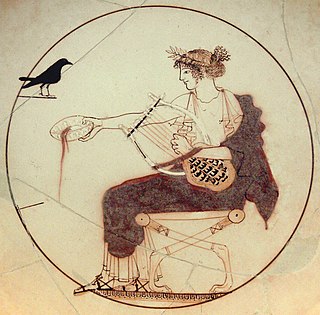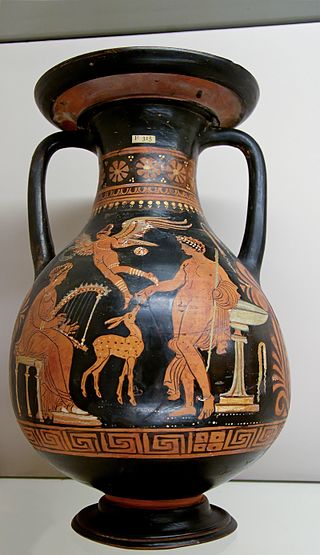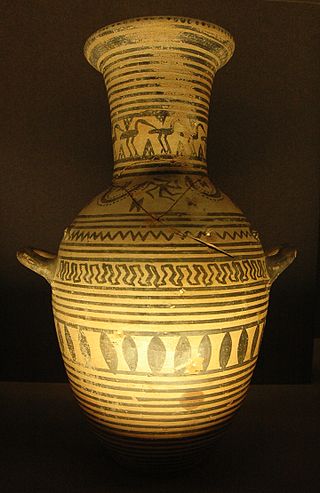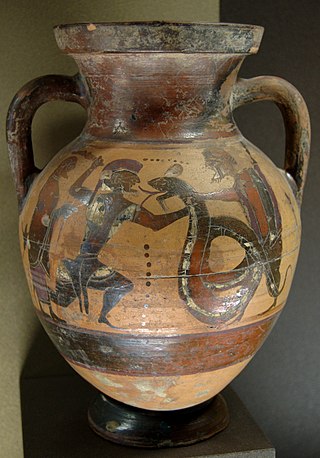
Pottery, due to its relative durability, comprises a large part of the archaeological record of ancient Greece, and since there is so much of it, it has exerted a disproportionately large influence on our understanding of Greek society. The shards of pots discarded or buried in the 1st millennium BC are still the best guide available to understand the customary life and mind of the ancient Greeks. There were several vessels produced locally for everyday and kitchen use, yet finer pottery from regions such as Attica was imported by other civilizations throughout the Mediterranean, such as the Etruscans in Italy. There were a multitude of specific regional varieties, such as the South Italian ancient Greek pottery.

Black-figure pottery painting, also known as the black-figure style or black-figure ceramic, is one of the styles of painting on antique Greek vases. It was especially common between the 7th and 5th centuries BCE, although there are specimens dating as late as the 2nd century BCE. Stylistically it can be distinguished from the preceding orientalizing period and the subsequent red-figure pottery style.

Red-figure vase painting is one of the most important styles of figural Greek vase painting.

Minoan pottery has been used as a tool for dating the mute Minoan civilization. Its restless sequence of quirky maturing artistic styles reveals something of Minoan patrons' pleasure in novelty while they assist archaeologists in assigning relative dates to the strata of their sites. Pots that contained oils and ointments, exported from 18th century BC Crete, have been found at sites through the Aegean islands and mainland Greece, on Cyprus, along coastal Syria and in Egypt, showing the wide trading contacts of the Minoans.
The Iapygians or Apulians were an Indo-European-speaking people, dwelling in an eponymous region of the southeastern Italian Peninsula named Iapygia between the beginning of the first millennium BC and the first century BC. They were divided into three tribal groups: the Daunians, Peucetians and Messapians. After their lands were gradually colonized by the Romans from the late 4th century onward and eventually annexed to the Roman Republic by the early 1st century BC, Iapygians were fully Latinized and assimilated into Roman culture.
Jewelry of the Etruscan civilization existed in several eras.

White-ground technique is a style of white ancient Greek pottery and the painting in which figures appear on a white background. It developed in the region of Attica, dated to about 500 BC. It was especially associated with vases made for ritual and funerary use, if only because the painted surface was more fragile than in the other main techniques of black-figure and red-figure vase painting. Nevertheless, a wide range of subjects are depicted.
Geometric art is a phase of Greek art, characterized largely by geometric motifs in vase painting, that flourished towards the end of the Greek Dark Ages, c. 900–700 BC. Its center was in Athens, and from there the style spread among the trading cities of the Aegean. The Greek Dark Ages lasted from c. 1100 to 750 BC and include two periods, the Protogeometric period and the Geometric period, in reference to the characteristic pottery style. The vases had various uses or purposes within Greek society, including, but not limited to, funerary vases and symposium vases.

In the Archaic phase of ancient Greek art, the Orientalizing period or Orientalizing revolution is the cultural and art historical period that began during the later part of the 8th century BC, when there was a heavy influence from the more advanced art of the Eastern Mediterranean and the Ancient Near East. The main sources were Syria and Assyria as well as Phoenicia and Egypt. With the spread of Phoenician civilization by Carthage and Greek colonisation into the Western Mediterranean, these artistic trends also influenced the Etruscans and early Ancient Romans in the Italian peninsula.

South Italian is a designation for ancient Greek pottery fabricated in Magna Graecia largely during the 4th century BC. The fact that Greek Southern Italy produced its own red-figure pottery as early as the end of the 5th century BC was first established by Adolf Furtwaengler in 1893. Prior to that this pottery had been first designated as "Etruscan" and then as "Attic." Archaeological proof that this pottery was actually being produced in South Italy first came in 1973 when a workshop and kilns with misfirings and broken wares was first excavated at Metaponto, proving that the Amykos Painter was located there rather than in Athens.

Etruscan art was produced by the Etruscan civilization in central Italy between the 10th and 1st centuries BC. From around 750 BC it was heavily influenced by Greek art, which was imported by the Etruscans, but always retained distinct characteristics. Particularly strong in this tradition were figurative sculpture in terracotta, wall-painting and metalworking especially in bronze. Jewellery and engraved gems of high quality were produced.

Apulian vase painting was a regional style of South Italian vase painting from ancient Apulia in Magna Graecia. It comprises geometric pottery and red-figure pottery.

Peucetian pottery was a type of pottery made in the Apulian region of southern Italy by the Peucetians from the beginning of the 7th to the 6th centuries BC. It is an indigenous type. Its production area occupied the space between Bari and Gnathia. The pottery was painted only in brown and black and was characterized by geometrical ornaments, swastikas, diamonds, and horizontal and vertical lines. These samples were mainly in the Late Geometric phase of ceramics with a close ornamental pattern. The second phase of the pottery since the 6th century BC is influenced strongly by the Corinthian vase painting. This is reflected both in the ornaments, decorations in the form of radiation, as well as a change to figurative representation. The third and final phase brings a shift in production methods. The pottery was hand-formed before the arrival of the Greeks in the southernmost tip of Italy, when the potter's wheel was introduced. The painting became purely ornamental. Shown on them are decorative plants like ivy and laurel vines and palmettes. Rare images included figurative and mythological figures.

Daunian pottery was produced in the Daunia, today's Italian provinces of Barletta and Foggia. It was created by the Daunians, a tribe of the Iapygian civilization who had come from Illyria.

Boeotian vase painting was a regional style of ancient Greek vase painting. Since the Geometric period, and up to the 4th century BC, the region of Boeotia produced vases with ornamental and figural painted decoration, usually of lesser quality than the vase paintings from other areas.

Euboean vase painting was a regional style of ancient Greek vase painting, prevalent on the island of Euboea.

East Greek vase painting was a regional style of ancient Greek vase painting, produced by the eastern Greeks. In spite of the region's wealth, the pottery was rather unremarkable in comparison to other areas. The clay is red-brown to pink and often contains mica inclusions. Many regional sub-styles of East Greek pottery existed.

Etruscan vase painting was produced from the 7th through the 4th centuries BC, and is a major element in Etruscan art. It was strongly influenced by Greek vase painting, and followed the main trends in style over the period. Besides being producers in their own right, the Etruscans were the main export market for Greek pottery outside Greece, and some Greek painters probably moved to Etruria, where richly decorated vases were a standard element of grave inventories.

Ancient Greek art stands out among that of other ancient cultures for its development of naturalistic but idealized depictions of the human body, in which largely nude male figures were generally the focus of innovation. The rate of stylistic development between about 750 and 300 BC was remarkable by ancient standards, and in surviving works is best seen in sculpture. There were important innovations in painting, which have to be essentially reconstructed due to the lack of original survivals of quality, other than the distinct field of painted pottery.

The mosaics of Delos are a significant body of ancient Greek mosaic art. Most of the surviving mosaics from Delos, Greece, an island in the Cyclades, date to the last half of the 2nd century BC and early 1st century BC, during the Hellenistic period and beginning of the Roman period of Greece. Hellenistic mosaics were no longer produced after roughly 69 BC, due to warfare with the Kingdom of Pontus and the subsequently abrupt decline of the island's population and position as a major trading center. Among Hellenistic Greek archaeological sites, Delos contains one of the highest concentrations of surviving mosaic artworks. Approximately half of all surviving tessellated Greek mosaics from the Hellenistic period come from Delos.

















